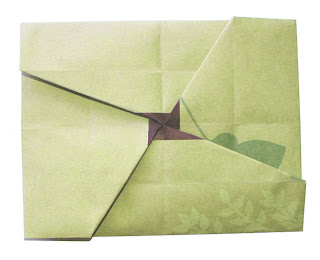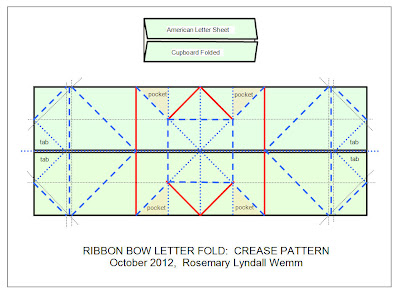This Letter Fold is a little more complicated than the previous collection. I would not recommend it for beginners. There are a lot of steps, some squash folds, sinks, pushes, reverse folds and refolds . Trying to remember how to fold them without prompts led to a lot of mistakes and a lot of frustration.
I made quite a few models along the way, mostly because I kept mangling the paper while trying to recall how I had folded it before. It didn't help that I had made a couple of models with the creases marked in colored pencil and the folds reinforced so that (at least theoretically) they models should refold themselves. Ha ha, not funny.
It took me two days (or was it three) to make a set of Step Folds . I actually got the Step Folds wrong the first time around (the colors were the wrong way around on one of the ends). I had to redo them today.
Once you get the hang of it the model only takes about ten to fifteen minutes to fold. The first attempt with unfamiliar instructions will take longer.
There are couple of tricks-of-the-trade that I will teach in classes that are too complicated to put into diagrammed instructions. They create greater accuracy and neater folds. If you are an old folder you will figure them out for yourself.
The model ends up as a long pleated strip that is connected together at the ends. The two ends are connected across the center line and covered by the diamonds in the center of the "bow". The pleated ring is squashed flat so that the decoration is mid center. It will stay flat provided that you are using ordinary weight writing paper rather than wallpaper or thick paper, both of which try to bounce back into a ring shape. Warning: the model is not suitable for cheap letter head paper which will crack and tear. This goes for cheap wrapping paper that will also crack.
The only part of the writing surface that is visible is the part that makes the outer part of the bows.
The model is connected together in two different ways.
There are a couple of triangles on the back of the decoration. A single layer triangle is fitted inside a double layer triangle, which is then bent down. The triangles that you can see at the tip of the models below is the double "female" triangle. The tab (male) triangle (not shown here) is on the other end or the paper strip.
The model is further secured with a couple of tabs that are pushed between the layers of the double triangle. The connection is fairly secure but still comes apart fairly easily when gently pulled.
You may agree that the end result is worth all the effort
There are a number of variations. Here is a sample of what can be done with the end that has the decorative center part on it. There are other variations not shown here, including a set of hearts in the middle.
Some of these variations are easier to undo quickly than others. Bear that in mind when deciding which one to use for your special friend. You don't want a letter fold than looks good but is ripped open because the reader cannot figure out how to pull it apart quickly.
I am not going to bother providing the Crease Pattern for this model. Unless you are of the caliber of Robert Lang you will not be able to figure out what to do with it. So if you want to fold this model you will just have to wait until I finish the diagrammed instructions. I'll let you know when that happens. It will not be tomorrow and maybe not even next week. I anticipate having to do a fair bit of hand drawing in order to make the tricky parts clear. Be patient.

































 Here is the back view.
Here is the back view.







.JPG)












